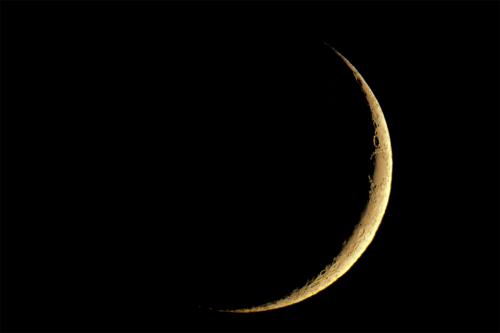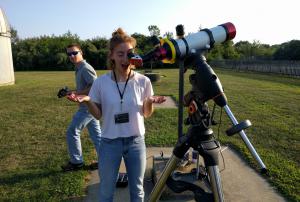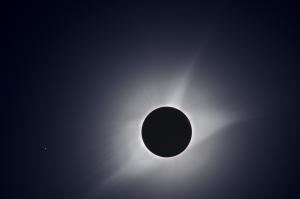Celebration of Space - March 8, 2024

The super thin waxing crescent Moon at 6%. Credit: Frosty Drew Astronomy Team member, Scott MacNeill captured this will the Observatory's 16 inch telescope.
On Sunday morning, March 10, 2024, Daylight Savings Time (DST) will kick in. The springtime DST time change is the rougher one as those who sleep at night will lose one hour of repose. A good reminder of which way to shift your clocks: “In the spring, spring ahead one hour. In the fall, fall back one hour.” If you have to be up on Sunday morning, be sure to change your clock before going to bed.
This coming Sunday, March 10, 2024, at 5:03 am EDT, the Moon will orbit into a position that’s between the Sun and Earth. This is called opposition and is the new Moon. On this day the Moon will rise and set with the Sun, leaving the Moon outside of the entire nighttime period. Also, the opposite side of the Moon will be in direct sunlight, with the side facing Earth in full night. The weeks around the new Moon are the best times to be out observing from a dark sky location like Ninigret Park – home to Frosty Drew Observatory. It should also be noted that this will be the last new Moon before the fantastic total solar eclipse on April 8, 2024, which will be the date of the next new Moon. So get out there and enjoy the dark sky, the coming slender waxing crescent Moon, and start gearing up for the eclipse.
Speaking of the solar eclipse, today marks one month’s time until the date of the fabulous eclipse. Regardless of where you are viewing from, the Northeast is set for a stunning view. That is if clouds can cut us a break. An old adage in astronomy states that purchasing new equipment will certainly bring cloudy sky conditions proportional to the equipment purchased. On the Frosty Drew Astronomy Team Discord server we have been reminding each other not to purchase any new gear, but of course one of our astronomers just had to pick up a massively huge white light filter for their 11 inch telescope. So now we are all doomed for a good view. Because of this we have speculated that if everyone purchases something awesome for astronomy, perhaps we can bring this weather thing around full circle?
Regardless, if the sky stays clear, the eclipse will be fantastic. For those traveling to locations that will experience totality (the period that the Moon completely eclipses the Sun), you will be able to observe the total period of the eclipse naked eye. That is once the Sun disappears behind the Moon, you can remove your eclipse glasses. Though the moment the Sun starts to reappear, put those glasses back on! Additionally, do not attempt an unfiltered view of the Sun in a telescope or binoculars during total eclipse, it’s just too risky. During the period of totality, which will last upwards of 5 minutes depending on where you are in the path of totality, take a moment to look around the sky. Venus will be visible to the naked eye about 15° west of the Sun. Jupiter will also be naked eye visible at 35° east of the Sun. Comet 12P/Pons-Brooks, which will be about 6° west of Jupiter, may be naked eye visible as well. Of course, don’t waste a lot of time during the eclipse looking for these things, as the corona will be a stunning sight, but take a moment to observe these phenomena.
In Southern New England we will experience a partial eclipse only, but a spectacular partial eclipse at that. The Moon will eclipse 89-91% of the Sun in Rhode Island at 3:28 pm. During that time it will appear quite dim outside. You may be able to spot Venus with the naked eye, just don’t look at the Sun without adequate eye protection. Frosty Drew Observatory and Science Center will not be hosting an onsite event for the eclipse, but many of our astronomers will be along the path of totality and will be live streaming the event to our YouTube, and our website. We’ll post additional information as the event approaches. Note that if the eclipse clouds out, we just may drop the name of our villainous filter purchasing astronomer.
On Tuesday, March 5, 2024, NASA opened the application process for the next generation of astronauts. These recruits will be the astronauts that go to the Moon and Mars. Have you ever considered being an astronaut? Perhaps you are a really amazing person that cares deeply about their community and the success and happiness of others? If so, you may be the right person to lead the next generation into space. Take a moment and visit NASAs application. Check out the requirements, and if there is a fit, submit that application. Hey, you may be the first person to set foot on another planet. You’ll never know until you try.
Over the past couple of weeks, China’s Tiangong station has been putting on regular evening passes for US sky watchers. Well this week the International Space Station (ISS) will join in the show, as it will return to the evening sky offering up stunning visible passes. Here are some notable passes of both stations for the coming nights:
ISS:
Tue, Mar 12 at 8:55 pm, starting in the SW, rising to 20°, and passing into orbital sunset
Wed, Mar 13 at 8:07 pm, starting in the SSW, rising to 43°, heading towards the ESE, and into orbital sunset
Thu, Mar 14 at 7:19 pm, starting in the S, rising to 25°, heading towards the ENE
Tiangong:
Fri, Mar 8 at 6:14 pm, starting in the W, rising to 68°, heading towards the ESE ← Awesome pass!
Sat, Mar 9 at 6:48 pm, starting in the W, rising to 31°, heading towards the SE, and into orbital sunset
Mon, Mar 11 at 7:21 pm, starting in the W, rising to 21°, heading towards the SSE
Even though the ISS has just started evening passes for its current orbital cycle, Tiangong will be wrapping up on Monday, March 11. After which, Tiangong will return to the early predawn morning sky on March 27, 2024. For daily pass times of the stations and other bright satellites, visit the Frosty Drew Daily Satellite Pass Prediction Utility. Now get out there and be amazed!
- Author:
- Scott MacNeill
- Entry Date:
- Mar 8, 2024
- Published Under:
- Scott MacNeill's Columns




